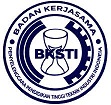Work hazards at workstations in the leather tanning industry using the Hazard Identification and Risk Assessment (HIRA) method
Abstract
Keywords
Full Text:
PDFReferences
H. O. Kalteh, S. B. Mortazavi, E. Mohammadi, and M. Salesi, “The relationship between safety culture and safety climate and safety performance: a systematic review,” Int. J. Occup. Saf. Ergon., vol. 27, no. 1, pp. 206–216, 2021, doi: 10.1080/10803548.2018.1556976.
J. González‐Caballero, “Occupational health nursing: Realities and challenges,” Int. Nurs. Rev., vol. 71, no. 3, pp. 513–520, Sep. 2024, doi: 10.1111/inr.12938.
N. Panjaitan, “Bahaya Kerja Pengolahan RSS (Ribbed Smoke Sheet) Menggunakan Metode Hazard Identification and Risk Assessment DI PT. PQR,” J. Sist. Tek. Ind., vol. 19, no. 2, pp. 50–57, 2017.
M. Akinlolu, T. C. Haupt, D. J. Edwards, and F. Simpeh, “A bibliometric review of the status and emerging research trends in construction safety management technologies,” Int. J. Constr. Manag., vol. 22, no. 14, pp. 2699–2711, 2022, doi: 10.1080/15623599.2020.1819584.
C. Yılmaz and A. H. Turan, “The causes of occupational accidents in human resources: the human factors theory and the accident theory perspective,” Int. J. Occup. Saf. Ergon., vol. 29, no. 2, pp. 796–805, 2023, doi: 10.1080/10803548.2022.2082677.
S. Supriyadi and F. Ramdan, “Hazard Identification and Risk Assessment in Boiler Division Using Hazard Identification Risk Assessment and Risk Control (HIRARC),” J. Ind. Hyg. Occup. Heal., vol. 1, no. 2, pp. 161–178.
S. Waruwu and F. Yuamita, “Analisis Faktor Kesehatan dan Keselamatan Kerja (K3) yang Signifikan Memengaruhi Kecelakaan Kerja Pada Proyek Pembangunan Apartemen Student Castle,” J. Spektrum Ind., vol. 14, no. 1, pp. 1–108, 2016.
R. Darmawan and dkk, “Identifikasi Risiko Kecelakaan Kerja Dengan Metode Hazard Identification and Risk Assessement (HIRA) Di Area Batching Plant Pt XYZ,” J. Tek. Ind., vol. 5, no. 3, pp. 308–313, 2017.
S. R. Desai, “Hazard Identi cation and Risk Assessment ( HIRA ) in the Autopsy Activity : An Observational Study,” Journal of Indian Society of Toxicology, vol. 19, no. 1, pp. 4–8, 2023, doi: 10.5958/0973-3566.2023.00002.0.
A. Rahmania, “The Risk Matrix of Occupational Health and Safety on Cleaning Service Occupation in Universitas X Ponorogo,” Med. Technol. Public Heal. J., vol. 7, no. 1, pp. 79–88, 2023, doi: 10.33086/mtphj.v7i1.3591.
B. Rout and B. Sikdar, “Hazard identification, risk assessment, and control measures as an effective tool of occupational health assessment of hazardous process in an iron ore pelletizing industry,” Indian J. Occup. Environ. Med., vol. 21, no. 2, p. 56, 2017, doi: 10.4103/ijoem.IJOEM_19_16.
K. A. Shamsuddin, M. N. C. Ani, A. I. Che-Ani, and A. K. Ismail, “Investigation the effective of the Hazard Identification, Risk Assessment and Determining Control (HIRADC) in manufacturing process,” Int. J. Innov. Res. Adv. Eng., vol. 8, no. September, pp. 2349–2163, 2015.
R. Thangaraj, A. R. Pandian, V. Ponnusamy, and M. Rajenderan, “Quantitative Risk Analysis Using HIRA in an Automotive Manufacturing Sector,” in Springer Proceedings in Materials, vol. 5, 2021, pp. 403–415. doi: 10.1007/978-981-15-8319-3_41.
N. A, I. E, and R. A. W, “Risk Management in Hazardous and Toxic Waste Management Companies using the HIRA (Hazard Identification and Risk Assessment) Method at PT.XY,” Int. J. Heal. Educ. Soc., vol. 4, no. 12, pp. 1–12, 2021, doi: 10.1234/IJHES.V4I12.208.
A. Nurissa’adah, E. Ismiyah, and A. W. Rizqi, “Analysis of Occupational Health, and Safety (K3) in the Workshop Area Using the HIRA and 5S Methods at PT. Ravana Jaya,” Motiv. J. Mech. Electr. Ind. Eng., vol. 4, no. 2, pp. 161–174, Jun. 2022, doi: 10.46574/motivection.v4i2.122.
C. A. Salsabila and D. Andesta, “Analysis of Occupational Health and Safety (OHS) on the Cable Tray Support Farming MSP Fabrication Project Using the Hazard Identifications and Risk Assessment (HIRA) and Hazard and Operability (HAZOP) Methods,” J. Tek. Ind. J. Has. Penelit. dan Karya Ilm. dalam Bid. Tek. Ind., vol. 10, no. 1, p. 147, 2024, doi: 10.24014/jti.v10i1.29692.
R. Pawin vivid, N. Selvakumar, and M. Ruvankumar, “Determination of hazard in truck manufacturing industry using hazard identification risk assessment technique,” Mater. Today Proc., vol. 27, pp. 1858–1862, 2020, doi: 10.1016/j.matpr.2020.04.006.
D. Kustono, P. Puspitasari, M. Al Irsyad, A. Nursabrina, and E. Y. T. Adesta, “Hazard Identification and Risk Assessment (Hira) Analysis of Nanotechnology Laboratory in Universities in Indonesia,” Int. J. Mech. Eng. Technol. Appl., vol. 2, no. 1, p. 41, Feb. 2021, doi: 10.21776/MECHTA.2021.002.01.6.
S. Jangle, A. Singh, B. Sharma, S. K. Saha, and A. Jha, “Risk assessment in the OPD of a tertiary care hospital: A study on HIRA application,” in The Journal of Chemical Physics, 2023, p. 030005. doi: 10.1063/5.0157500.
A. Nursabrina and T. Joko, “Risk Management in Hazardous and Toxic Waste Management Companies Using the HIRA (Hazard Identification and Risk Assessment) Method at PT XY Batam City,” Int. J. Heal. Educ. Soc., vol. 4, no. 11, pp. 1–12, 2021.
S. G. Lee, G. U. Park, Y. R. Moon, and K. Sung, “Clinical characteristics and risk factors for fatality and severity in patients with coronavirus disease in korea: A nationwide population-based retrospective study using the korean health insurance review and assessment service (hira) database,” Int. J. Environ. Res. Public Health, vol. 17, no. 22, pp. 1–13, 2020, doi: 10.3390/ijerph17228559.
S. Ngxesha, C. Deacon, and J. Smallwood, “Musculoskeletal Disorders Among Construction Workers,” Phys. Ergon. Hum. Factors, vol. 147, pp. 148–157, 2024, doi: 10.54941/ahfe1005187.
F. Mallapiang, M. Amansyah, A. Majid, H. R. Lagu, and A. I. Thaha, “Gambaran Kecelakaan Kerja, Penyakit Akibat Kerja dan Postur Janggal Pada Pekerja Armada Mobil Sampah Tangkasaki’ di Kota Makassar,” Al-Sihah Public Heal. Sci. J., vol. 10, no. 1, pp. 48–62, 2018.
V. Arumugaprabu, S. Ajith, J. Jerendran, K. Naresh, dan P. S. Rama Sreekanth, “Hazard identification and risk assessment using integrated exposure frequency and legislation requirements (HIRA-FL) in construction sites,” Mater. Today: Proc., vol. 56, no. 3, pp. 1247–1250, 2022, doi: 10.1016/j.matpr.2021.11.178.
V. Patel, A. Chesmore, C. M. Legner, and S. Pandey, “Trends in Workplace Wearable Technologies and Connected‐Worker Solutions for Next‐Generation Occupational Safety, Health, and Productivity,” Adv. Intell. Syst., vol. 4, no. 1, 2022, doi: 10.1002/aisy.202100099.
J. G. Park, J. Sim, and S. B. Han, “Association between intra-articular hyaluronic acid injections in delaying total knee arthroplasty and safety evaluation in primary knee osteoarthritis: analysis based on Health Insurance Review and Assessment Service (HIRA) claim database in Republic of Korea,” BMC Musculoskelet. Disord., vol. 25, no. 1, 2024, doi: 10.1186/s12891-024-07698-2.
B. Suhardi, P. W. Laksono, V. E. A. Ayu, J. Mohd.Rohani, and T. S. Ching, “Analysis of the potential Hazard Identification and Risk Assessment (HIRA) and Hazard Operability Study (HAZOP): Case study,” Int. J. Eng. Technol., vol. 7, no. 3, pp. 1–7, 2018, doi: 10.14419/ijet.v7i3.24.17290.
A. R. D. Utami, “Terapan Standar Operasional Prosedur Keselamatan dan Kesehatan Kerja,” Higeia J. Public Heal. Res. Dev. , vol. 4, no. Special 1, p. 5, 2020.
A. S. Mariawati, A. Umyati, and F. Andiyani, “Analisis penerapan keselamatan kerja menggunakan metode Hazard Identification Risk Assessment (HIRA) dengan pendekatan Fault Tree Anlysis (FTA),” J. Ind. Serv., vol. 3c, no. 1, pp. 293–300, 2017.
S. Sari and N. Nouryend, “Identifikasi potensi bahaya dan pengendaliannya dengan hazard identification risk assessment and risk control,” J. Ind. Serv., vol. 7, no. 2, p. 217, 2022, doi: 10.36055/jiss.v7i2.12265.
DOI: http://dx.doi.org/10.62870/jiss.v10i2.28760
Refbacks
- There are currently no refbacks.
 is supported by
is supported by








